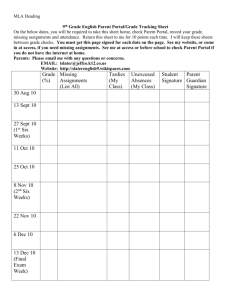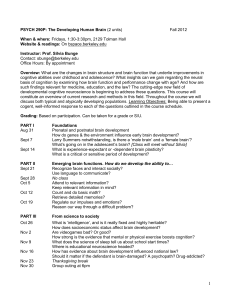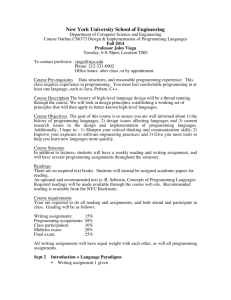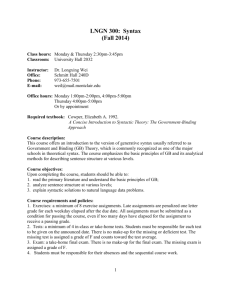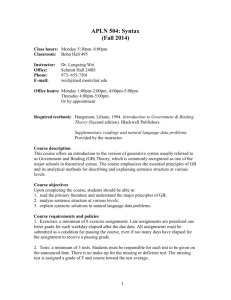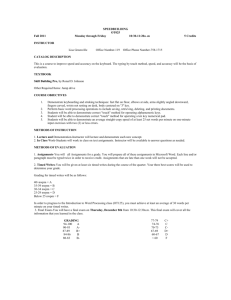Division of Education - Philander Smith College
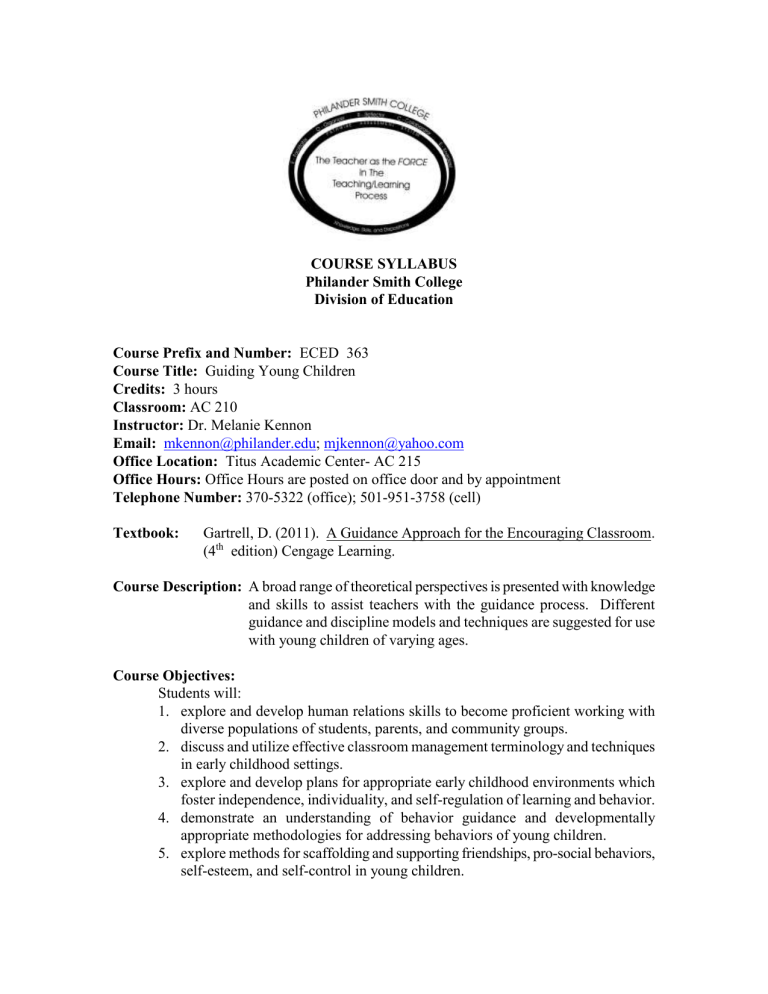
COURSE SYLLABUS
Philander Smith College
Division of Education
Course Prefix and Number: ECED 363
Course Title: Guiding Young Children
Credits: 3 hours
Classroom: AC 210
Instructor: Dr. Melanie Kennon
Email: mkennon@philander.edu
; mjkennon@yahoo.com
Office Location: Titus Academic Center- AC 215
Office Hours: Office Hours are posted on office door and by appointment
Telephone Number: 370-5322 (office); 501-951-3758 (cell)
Textbook: Gartrell, D. (2011). A Guidance Approach for the Encouraging Classroom.
(4 th
edition) Cengage Learning.
Course Description: A broad range of theoretical perspectives is presented with knowledge and skills to assist teachers with the guidance process. Different guidance and discipline models and techniques are suggested for use with young children of varying ages.
Course Objectives:
Students will:
1.
explore and develop human relations skills to become proficient working with diverse populations of students, parents, and community groups.
2.
discuss and utilize effective classroom management terminology and techniques in early childhood settings.
3.
explore and develop plans for appropriate early childhood environments which foster independence, individuality, and self-regulation of learning and behavior.
4.
demonstrate an understanding of behavior guidance and developmentally appropriate methodologies for addressing behaviors of young children.
5.
explore methods for scaffolding and supporting friendships, pro-social behaviors, self-esteem, and self-control in young children.
6.
explore and apply theories of behavior and guidance most appropriate at a variety of age and developmental levels with diverse populations of students.
7.
explore issues of diversity which may affect the classroom environment.
8.
discuss effective techniques for managing diverse groups of students and problem and typical behaviors which they may encounter in early childhood settings.
9.
explore ways to build and support the parent/teacher/caregiver relationship.
10.
discuss the components of social competence and motivation in young children and teaching strategies that foster social development.
Dispositions : Upon completion of this course, candidates will be able to:
1.
2.
3.
4.
Demonstrate a sense of caring.
Demonstrate how to establish rapport with children.
Demonstrate a sense of efficacy.
Demonstrate how to model a positive attitude towards children.
5. Demonstrate how to model respect for children
Technology: Upon completion of this course, candidates will be able to:
1. understand how to use technology to enhance learning
2. understand how to use technology to locate, evaluate, and collect information from a variety of sources.
Course Content
Aug 16: Introduction to course and Foundations of the Guidance Approach
(Chapter 1)
Aug 21:
Aug 23:
Aug 28:
Aug 30:
Chapter 1 cont. (intentionality, goals of guidance, valuing differences,
DAP expectations)
Guidance and Child Development (Chapter 2)
Chapter 2 cont. (Piaget, Vygotsky, Erikson, Gardner, helping children manage their feelings)
Chapter Check Point (Chapt. 1-2)
Mistaken Behavior (Chapter 3)
Sept 4:
Sept 6:
Sept 11:
Sept 13:
Sept 18:
Chapter 3 cont. (Driekurs, Harlow, superhero syndrome, Gartrell, influences that create discipline problems)
Reducing Mistaken Behavior/Partnerships with Parents (Chapter 4)
Chapter 4 cont. (Proactive and responsive discipline intervention, teacher responsiveness, self-fulfilling prophecy, unconditional positive regard, logical and natural consequences, “I” messages, moving toward self-regulation, behavior models) Article Summary
Due.
Chapter Check Point (Chap.3-4)
Organizing the Encouraging Classroom (Chapter 5)
Chapter 5 cont. (4 characteristics of a well-managed classroom,
Wong, DAP physical layout, learning centers, thematic instruction)
Sept 20:
Sept 25:
Sept 27:
Oct 2:
Oct 4:
Oct 9:
Oct 11:
Oct 16:
Oct 18:
Oct 23:
Oct 25:
Oct 30:
Nov 1:
Nov 6:
Nov 8:
Nov 13:
Nov 15:
Nov 20:
Nov 27:
Nov 29:
Dec 3-8:
Managing the Encouraging Classroom (Chapter 6) (social space, procedures, indirect guidance, scheduling)
Chapter 6 cont. (transitions, pacing, traffic patterns, rules of the road and developmental interpretation, DAP scheduling, inclusion)
Chapter Check Point (Chap 5-6) (Procedures due.)
Leadership Communication/ Guidelines for Groups (Chapter 7)
Chapter 7 cont (routines and guidelines, logical consequences,
Driekurs, encouragement, class meetings, Glasser, contracts, democratic classroom, parent-teacher conferences)
Review activity for midterm (Letter to Parents due.)
Midterm Exam (Chapters 1-7)
Leadership Communication with Individual Students/ Effective
Feedback (Chapter 8) (listening for stress, establishing trust, feedback sandwich, appropriate use of humor)
Chapter 8 cont
Using Conflict Management to Solve Social Problems (Chapter 9)
Chapter 9 cont. (negotiation, mediation, social problem-solving)
Chapter Check Point (Chapters 8-9)
Problem-Solving and Intervention Strategies (Chapter 10)
Chapter 10 cont. (Kounin, with-it-ness, consistency, when to intervene, non-verbal techniques, broken record technique, NAEYC code of ethical conduct, support services, inviting choices, Premack
Principle)
Intervention and Crisis Management Techniques (Chapter 11)
Chapter 11 cont.(cool-down time rather than time-out, “Safe” chair, restitution and reconciliation, Individual Guidance Plans, labeling vs diagnosis)
Guiding Outdoor Play and Learning (challenge vs. hazard, turntaking and games with rules, teaching vs. supervising, field trips, emergencies) (Classroom Behavior Plan due.)
Chapter Check Point (Chapters 10, 11, and outdoor play)
Liberation Teaching: A Guidance Response to Violence in Society
(Chapter 12) (reaction to violence in society, family violence, coping with disasters, resiliency, bullying, peace education)
Managing Special Learners (ADHD, ADD, emotional/ behavior disorders, physical disabilities, inclusion)
Infants, Preschoolers, Toddlers- Typical Problem Behaviors
Infants, Preschoolers, Toddlers cont. (biting, hitting, non-compliance, screaming, temper tantrums, etc.) (Individual Behavior Guidance
Plan due.)
Role of Parents and Caregivers (collaborating with families)/ review for final exam
Finals
Assignments, Evaluation Procedures, and Grading Policy:
1. Two examinations. (200 total).
2.
Chapter Check Points (5 x 20 points each=100 total)
3.
Classroom Behavior Plan (50 points) (Due Nov. 8)
4.
Case study analysis/ Individual Behavior Guidance Plan (50 pts.) (Due Nov. 27)
5.
Introductory letter to parents containing age-appropriate classroom rules, procedures, methods of communication, and other pertinent information concerning student learning. (50 pts.) (Due Oct 4)
6.
DAP Classroom procedures. Design classroom procedures for three areas or tasks in your classroom. Procedures should be typed and ready to post in your classroom. For example, hand-washing, learning centers, homework, walking in the hallway, cleanup, morning routine (50 pts.) (Due Sept. 27)
7.
Read and summarize one journal article from Young Children. Acceptable topics will be approved by the instructor. 1-2 pages in length, typed. APA citation. Summary should include key points made by the article and your reaction to the article (25 points total). (Due Sept.11)
8.
Participation in class discussions of case studies, chapter questions, etc. and attendance (50 pts.)
Expectations:
1.
Students must turn off cell phones or put them on a mode that will not disrupt teaching and learning. DO NOT take cell phone calls during class unless it is an emergency. DO NOT text message during class. It is rude and distracting to the professor and other students. Students who do not comply with this request will be asked to leave the class.
2.
Students are expected to complete the reading of all textbook material and are responsible for all materials discussed in class. Participation in class discussions enhances your understanding of the subject matter and, therefore, affects your grade . Simply sitting in class does not earn you participation points. You will be expected to actively engage in classroom discussions and activities.
3.
All assignments must be typed unless otherwise specified.
4.
Academic integrity is expected . Plagiarism and cheating are serious academic offenses, and will result in an automatic grade of F.
5.
There are no extra credit assignments in this class so it is in your best interest to put forth maximum effort on the assignments given. You may always turn in assignments earlier than the date due for feedback from the instructor so you may make necessary changes to ensure earning maximum points possible for the assignment.
6.
Absences and tardiness from class show a disinterest in the class and a lack of your desire to learn and earn a good grade. For that reason, absences and tardies will
have an effect on your grade as it is impossible to make up discussions and
lectures that you miss. Any missed quizzes, assignments, or exams must be made up within one week of the absence or they will convert to a zero.
Grading:
Total Class points= 575
A= 518-575
B= 460-517
C= 403-459
Below a C grade student must retake the course.
Teaching Strategies
_X_Lecture
_X_Discussion/Questioning
_X_Small Group Activities
_X_Demonstration/Modeling/Model
_X_Cooperative Learning
_X_Role Playing
_X_Problem Solving
___Discovery Learning
Teaching Models:
_X_Direct instruction Model
___Technology/Media Presentation
___Team Teaching
___Individualized Instruction
__X_Other(s): Case study analysis
____ Guided field observations
___General Inquiry Model
_X_Inductive Model _X_Deductive Model
Disability Statement:
It is the policy of Philander Smith College to accommodate students with disabilities, pursuant to federal and state law. Also, any student who is physically challenged (i.e., hearing or visual impaired) should inform the instructor at the beginning of the course. This course adheres to the students with disabilities policy outlined in the 2011-
2013 Philander Smith College Catalog.
Bibliography:
Bredecamp, S. (1987). Developmentally appropriate practice in early childhood programs serving children from birth through age 8. Washington, DC: National Association for the Education of Young Children.
Bredecamp, S., & Rosegrant, T. (Eds.) (1992) Reaching potentials: Appropriate curriculum and assessment for young children. Vol. 1. Washington, DC: National Association for the Education of Young Children.
Crary, E. (1992) (rev. ed.) Without spanking or spoiling: A practical approach to toddler and preschool guidance. Seattle, WA: Parenting Press.
Elkind, D. (1995). A sympathetic understanding of the child. Boston: Allyn & Bacon.
Fuller, M.L. & Olsen, G. (1998). Home-school relations: working successfully with parents and families. Boston: Allyn & Bacon.
Gordon, A & Browne, K.W. (1996) Guiding young children in a diverse society. Boston:
Allyn and Bacon.
Hearron, P.F & Hildebrand, V .(2009) Guiding young children. 8 th
edition. Columbus:
Pearson Publishing.
Jones, F. (2000). Tools for teaching. Santa Cruz, CA: Fredric H. Jones & Associates, Inc.
Nelson, J. (1987). Positive Discipline. New York: Ballantine Books.
Reynolds, E. (2001) Guiding young children: A problem-solving approach. Mountain View,
CA: Mayfield Publishing.
Wong, H.K. & Wong, R.T. (2001) The first days of school: How to be an effective teacher.
Mountain View, CA: Harry Wong Publications, Inc.

